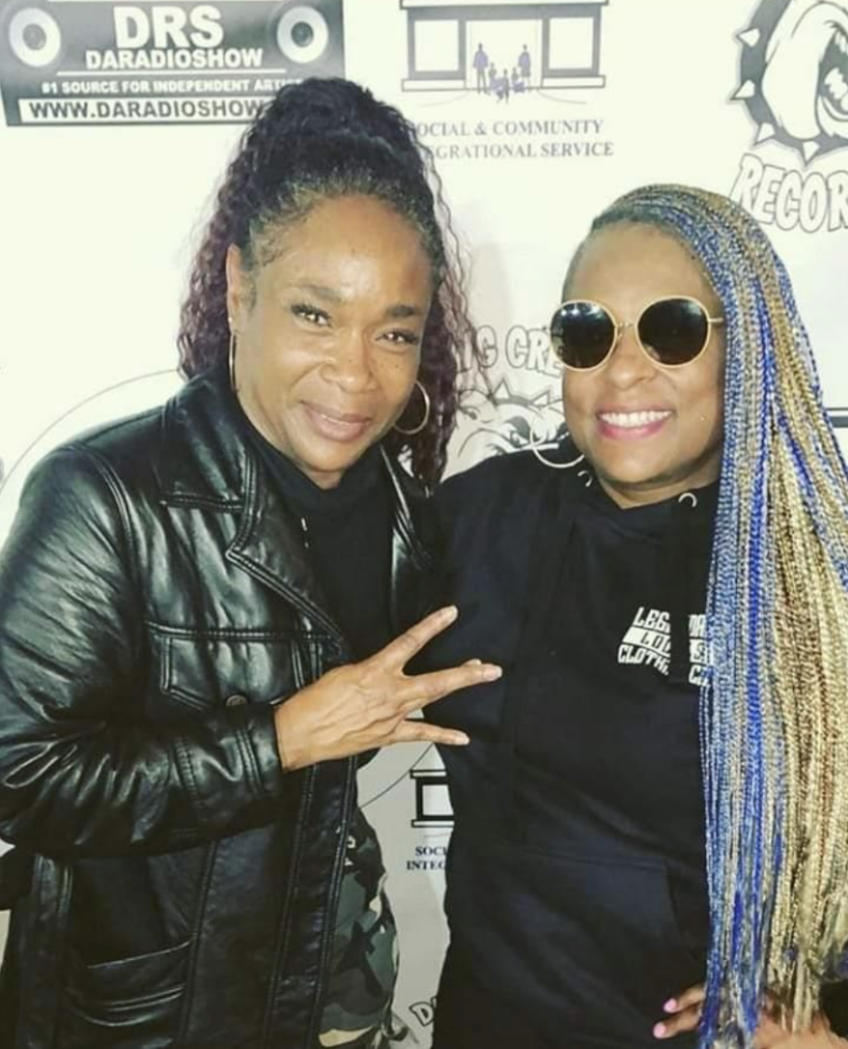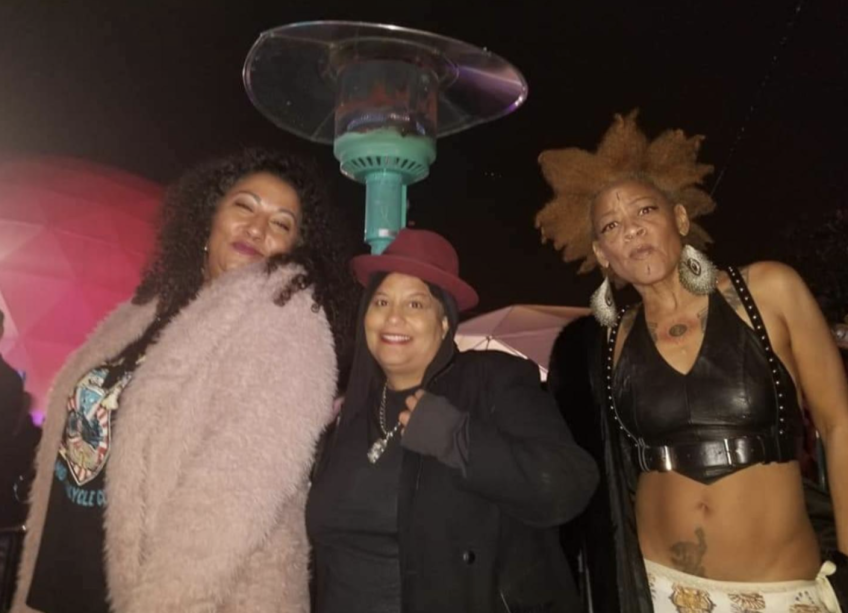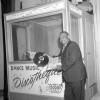Rise of the Fly Girls: The Compton and South Central Women Who Helped Shape West Coast Hip Hop

The following essay is part of "Compton: Arts and Archives," which explores the history, arts and culture that make the “Hub City” an arts city. It is cross-published from Sēpia Collective in response to its "Reading the City" conversations with Compton artists. Edited by Jenise Miller.
I fell in love with Hip Hop in 1979. I would sit with a piece of paper, my ears glued to the speaker, writing out a song word for word. Reciting the lyrics made me feel cool and empowered. Hip Hop was storytelling that gave a glimpse into the day-to-day lives of people who looked just like me. Bios of their lives on wax. Hip Hop was born on Aug. 11, 1973, in the Bronx, New York, at a back-to-school party hosted by DJ Kool Herc. It came from a place of creativity, lack of resources and escape from the day-to-day issues tied to politics, strikes and poverty in New York's Black and Brown communities. Record players would become instruments for DJs, breakbeats would be the music to the ears of breakdancers aka B-girls and B-boys, the mic would embrace the symphony of words out of the mouths of emcees, spray paint would dance on the blank canvases from the hands and minds of graf writers. Hip Hop would carve out a lifestyle that became instilled in the core of the culture; the determination and imagination of a community that stuck together, knew how to have a good time and looked out for each other would turn into a multibillion-dollar industry and global phenomenon that still thrives almost 50 years later.
Hip Hop artists from Compton and South Los Angeles stepped into the game in the 1980s, when the music was just starting to gain national recognition. Some would say that Compton put Hip Hop on the map on the West Coast. The hot spots Eve After Dark, Compton's Skateland U.S.A. roller skating rink, Dooto’s, and the legendary party and DJ crew, Uncle Jamm's Army, would give the world a broad spectrum of talented people that walked in the spirit and culture of Hip Hop. The World Class Wreckin' Cru (WCWC) — Alonzo Williams, CLi-N-TEL, Dr. Dre and DJ Yella (Shakespeare, Dr. Rock) — set the bar for West Coast rap music in the early 80s. Later, Dr. Dre linked up with Eazy-E, Ice Cube, DJ Yella and MC Ren (Arabian Prince was also initially part of the group) to give a raw sound to the stories and day-to-day issues of Black and Brown communities in L.A., just like in New York. These artists opened the doors for women Hip Hop artists to showcase their talent in the 80s and 90s in the West Coast world of Hip Hop. Much respect to Rose Hutchinson and Dee Barnes — who formed the Hip Hop duo Body and Soul in the 1980s. They released their debut EP "Dance to the Drummers Beat" on Delicious Vinyl Records. Dee Barnes, who had a former career in radio, would go on to host a music video show "Pump It Up," and own successful production company, Eastside Entertainment. DJ Silky D became the only female DJ in Uncle Jamm's Army. Then there was Mona Lisa, a talented singer from South L.A. who worked with WCWC, along with singer Michel'le, who belted out the chorus on WCWC's hit "Turn Out the Lights." Eazy-E signed J.J. Fad (hailing from Rialto), who, along with Salt N' Pepa, was the first female Hip Hop group nominated for a Grammy award, as well as Charis Henry, who would become an influential entrepreneur and executive in the music industry. Ice Cube introduced Yolanda "Yo-Yo" Whitaker, who exploded onto the Hip Hop scene to become a leading voice in Hip Hop from the West Coast. Rappers Medusa and Feline Science, T-Love, Sonja Marie, DJ Spark and Ava DuVernay, also from Compton and South Central, thrived in L.A.'s underground Hip Hop scene and graced the stages at places like Club Nappy at The Roots, KAOS Network, The Good Life, Project Blowed, spaces rooted in L.A. Hip Hop and community.


When people name their favorite Hip Hop artist, many will not name a female artist or group, nor would a female artist make their top 10 list. Women have not been given the same level of respect as Hip Hop artists and creatives as their male counterparts. On December 9, 2021, Sēpia Collective brought two trailblazing women in the emergence of Hip Hop on the West Coast, music executive Charis Henry and rapper and philanthropist Yolanda "Yo-Yo" Whitaker, together with scholar and activist Martha "MD" Diaz. The discussion, "Reading the City: Compton FreeStyle," was an essential conversation on the too-often untold or overlooked role of women as artists and entrepreneurs, particularly from Compton and South L.A., in Hip Hop's development on the west coast.


Charis Henry (pronounced Shar REE) started as a rapper signed by Eazy-E to his and Jerry Heller's Ruthless Records but quickly realized her heart and acumen for the business side. Henry rose to become a well-respected entrepreneur and businesswoman. She was the right hand to the late artist Eazy-E and helped to produce and shape the careers of artists from Flavor Unit Records, King T and a list too long to name. She can take a peep at a contract or agreement and leave it with so many redlines it looks like a spirograph drawing. She is a genius when it comes to business and is revered for her high level of integrity, wit and keen ear in the recording studio, which she attributes to working with Compton artists: "I was blown away by just the rawness, the politicized message that it had. And then to be able to work with the kings, and I'm talking about kings, I managed King T for many years. I worked with Dr. Dre and executive produced projects with him for many years. I worked with Eazy for many, many years. And to be able to sit with these guys… sometimes 18 hours a day in the studio. That made me one of the most, I think, prolific and best ears in this business. I can work an SSL board like I'm the engineer, based upon Compton genius." As the gatekeeper to one of the most prolific rappers and businessmen to come from Compton, Henry's first-hand experiences and behind-the-scenes work made her the shrewd businesswoman that she is today and as much of a game-changer as Eazy-E. Hip Hop on the west coast began with dancing and breaking music before transitioning to the gangster rap sound that put Compton on the map. In turn, as Henry stated, "Compton put Los Angeles on the map."
A trailblazing rapper, actress, entrepreneur and educator, Yo-Yo was raised in the Black neighborhoods of Los Angeles, which was key to her understanding the experiences of Black women on the West Coast. The darling of West Coast Hip Hop explained why she also represents as the "California Cutie": "growing up in Hip Hop in early '89… I never wanted to block myself in. But for me, I grew. I was born in Lynwood…and we moved to Carson and then we moved… a little bit everywhere…then we moved to South Central where I got my start…I can understand who Compton is and who Compton was because I am Compton. But I'm California and I am everywhere I go…I'm not just one place…I understand the struggles that we have been through and what we go through, not just as artists, but as people… I am Compton. It inspired me to be the woman that I am today." With songs like "You Can't Play With My Yo-Yo" and "Black Pearl," Yo-Yo entered the west coast Hip Hop scene and advocated female empowerment and a low tolerance for sexism and misogyny normalized in Hip Hop music and the community. It didn't come easy: "Hip Hop was so male-dominated… You think of it as a football game. Nobody wanted to put the women in…it became this thing that you have to prove yourself…they wouldn't accept us being [ourselves], they wouldn't accept my 28-sized jeans and that little cute waist and pretty-in-the-face and green eyes. They put overalls on me. They put a hat on my head. They put a bandana around my head, you know? They couldn't accept me for just being a woman… when I got pregnant. It was one of the times that I just was like, 'Oh, I can't tell anybody, I felt like I was letting them down, that they let a girl in… Now the money they've put into me, they got to, I don't know if they got to put it on hold, because it just seemed like a woman wasn't supposed to be here." From the encouragement of her mother, affectionately known as "Momma Mia," to establishing the crew, The Intelligent Black Women's Coalition (IBWC), Yo-Yo represented women in Hip Hop speaking for themselves.
They say "the West Coast is the best coast." But Martha Diaz aka "MD" repped for the East Coast perspective of witnessing the rise of women from Compton and South Central in Hip Hop: "...it really made an impression on me. And so did the women from Medusa to, of course, Yo-Yo, and, you know, Ava and J.J. Fad. When I heard J.J. supersonic, I was like, what?... Oh, style and so much props and love to Compton. All the women in Hip Hop in California...It was interesting because hearing 'You Can't Play With My Yo-Yo' we saw the similarities, we saw that Queen Latifah is like 'who you callin' a b—!' and, you know, and saying it her way. And here comes Yo-Yo, 'You Can't Play with My Yo-Yo.' And it was just like, women are speaking up in the East Coast and West Coast. And it really…changed how women were being perceived, especially during that time."


An educator, author, media producer, social entrepreneur, archivist, and Founder and Director of the Hip Hop Education Center, MD's work preserves Hip Hop history and shares accurate information about women in the Hip Hop industry, through archives, research, and storytelling. She recognized Yo-Yo's significance in the Hip Hop education space: "We know that California has been a trailblazer in this education space with Hip Hop and education. Yo-Yo, was probably the first artist, female artist, that I know of that really used Hip Hop in the education field." Yo-Yo created the Yo-Yo School of Hip Hop to pass the torch and expose youth to experiences that shaped who she became and the road she traveled – "I never really got a chance to even understand who I was as a woman as a person, and to travel and to see how big Hip Hop was, I was 17. I never knew how big Hip Hop was, I never knew what living rooms we were playing in. I never knew the impact that it would have on a community."
Compton and South Los Angeles will always be the foundation of Hip Hop and influence on the West Coast and, as MD noted, "there are many milestones for women in Hip Hop that we have to thank California, specifically Compton, for our development." Community and the support of family planted the seeds for all of these women to grow and become trailblazers who made a lifetime commitment to Hip Hop culture. They represent the beginning of a long journey to shift how women are viewed and respected as leaders in Hip Hop. Outside being an emcee, B-girl, DJ and graf writer, they inspired artists, educators, executives, producers, promoters all over the globe. Their roles and path are a critical part of the foundation and structure of today's Hip Hop world.

Editor's Note: An earlier version of this article misstated that DJ Silky D was from Compton. She is from South Central. The correction made Nov. 28, 2022.







